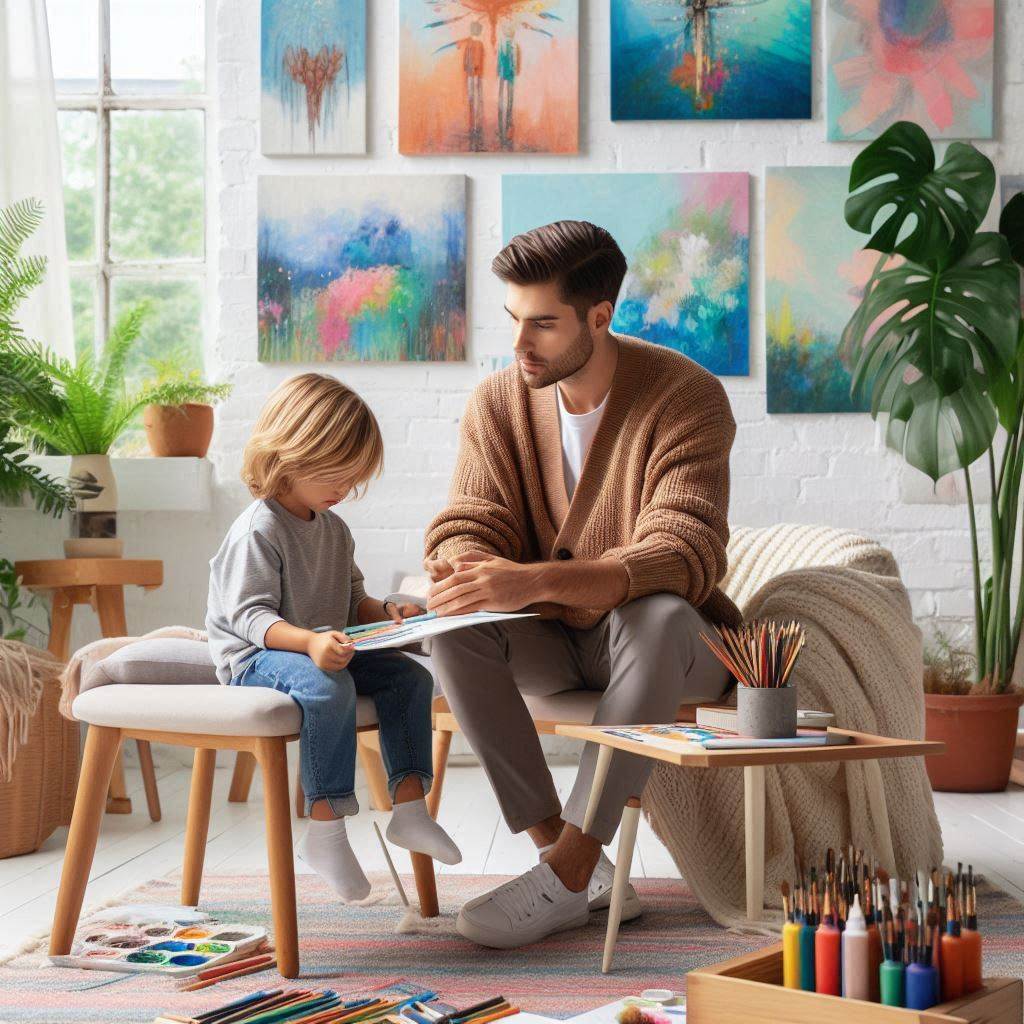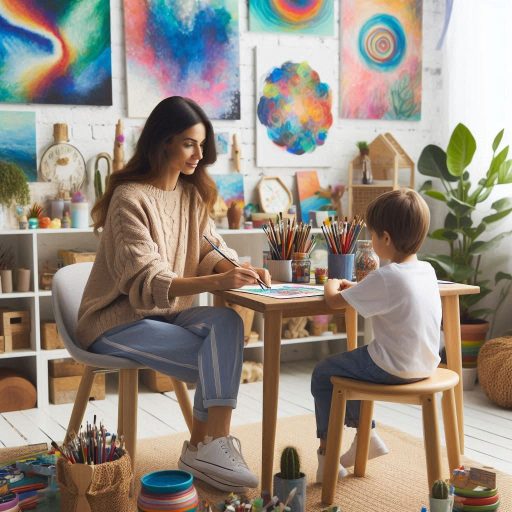Introduction
Art therapy is a creative approach that uses artistic expression to promote emotional healing.
It helps clients explore feelings and communicate experiences non-verbally.
By engaging in various art forms, individuals access emotions that may be difficult to express in words.
Art therapists play vital roles in this transformative process.
They conduct assessments to understand clients’ needs and develop personalized treatment plans.
Additionally, they guide clients through artistic activities that encourage self-exploration and expression.
Art therapists also collaborate with other mental health professionals to provide comprehensive care.
The importance of art therapy in mental health treatment is significant.
It serves as an effective alternative for individuals who struggle with traditional talk therapy.
Many clients facing anxiety, depression, and trauma find solace in creative expression.
Art therapy fosters healing by promoting resilience and emotional regulation.
Through this therapeutic approach, clients navigate their emotional landscapes in a supportive environment.
Overall, art therapy enriches the mental health treatment landscape, empowering individuals to grow and heal.
Education and Training Required to Become an Art Therapist
To become an art therapist, you must fulfill specific educational and training requirements.
Start with a bachelor‘s degree in psychology, art therapy, or a related field.
This foundational education prepares you for advanced studies in art therapy.
Courses in psychology help you understand mental health principles.
Classes in art therapy introduce you to therapeutic techniques and the creative process.
Bachelor’s Degree in Psychology, Art Therapy, or Related Field
A bachelor‘s degree in psychology, art therapy, or a related field is essential.
This degree provides a comprehensive understanding of human behavior and emotional well-being.
You will take courses in developmental psychology, cognitive psychology, and art principles.
These courses help build a solid foundation for your future studies.
Master’s Degree in Art Therapy
Next, pursue a master‘s degree in art therapy.
This degree is crucial for developing specialized skills.
Graduate programs often include theoretical coursework, hands-on training, and internships.
You‘ll study various therapeutic approaches and artistic methods.
Programs typically cover subjects like counseling techniques, human development, and ethics in art therapy.
This comprehensive education builds a strong foundation for your practice.
During your master‘s program, you‘ll engage in clinical experience.
Most programs require supervised internships.
These internships provide hands-on practice in real-world settings.
You‘ll work with clients under the supervision of licensed professionals.
This experience is vital for applying theoretical knowledge in practical situations.
Internships also help you develop your unique therapeutic style.
Clinical Experience and Licensure Requirements
After completing your master’s degree, you must meet licensure requirements.
Each state has different regulations regarding art therapy licensure.
Research your state‘s specific requirements to ensure compliance.
Most states require a minimum number of supervised hours.
This typically involves 1,000 to 2,000 hours of clinical experience.
Ensure you accumulate enough hours during your internship to meet this requirement.
You‘ll also need to pass a licensing exam.
Many states use the Art Therapy Credentials Board (ATCB) exam for this purpose.
This exam tests your knowledge and skills in art therapy.
Passing the exam demonstrates your competence as a professional.
Once you achieve licensure, you can practice legally as an art therapist.
Continuing education is essential for art therapists.
Stay updated on the latest practices and research in the field.
Many states require ongoing education to maintain your license.
Attend workshops, conferences, or additional courses to expand your knowledge.
Engaging in professional development enhances your skills and benefits your clients.
Becoming an art therapist involves a structured educational path.
Start with a bachelor‘s degree, followed by a master‘s in art therapy.
Gain valuable clinical experience through internships, and fulfill state licensure requirements.
Finally, commit to ongoing education to remain effective in your practice.
With dedication and the right training, you can help clients heal and express themselves through art.
Read: Character Design Trends: What‘s Hot in 2024?
Assessment and evaluation of clients
Assessment and evaluation are crucial steps in the art therapy process.
These steps help therapists understand their clients’ needs and design effective treatment plans.
Art therapists employ various techniques to gather information about clients.
This process establishes a solid foundation for therapy.
Conducting Initial Assessments to Understand Clients’ Needs and Goals
The first step in assessment involves conducting initial evaluations.
Art therapists meet with clients to discuss their backgrounds and reasons for seeking therapy.
They ask questions about clients’ emotional states, personal histories, and specific goals.
This conversation helps therapists identify the areas needing attention.
In these initial sessions, therapists may also use questionnaires and standardized assessment tools.
These tools provide valuable insights into clients’ mental health and emotional well-being.
The information gathered during these assessments informs the therapeutic process.
It allows therapists to tailor their approach based on individual client needs.
Using Art Techniques to Evaluate Clients’ Emotional and Mental Health
Art techniques play a vital role in assessing clients’ emotional and mental health.
Therapists encourage clients to create artwork as a means of self-expression.
This creative process reveals insights that may not surface through traditional verbal assessments.
For example, color choices, subject matter, and artistic styles can provide clues about clients’ emotional states.
Therapists analyze the artwork for recurring themes and symbols.
They consider how clients describe their artwork during discussions.
This evaluation process helps therapists gauge clients’ emotional expressions and coping mechanisms.
The artwork acts as a visual representation of clients‘ thoughts and feelings, offering a unique perspective.
Developing Treatment Plans Based on Assessment Findings
After completing the assessment process, therapists develop individualized treatment plans.
These plans outline specific therapeutic goals and interventions based on assessment findings.
Therapists consider clients’ unique needs, strengths, and challenges when creating these plans.
Treatment plans typically include short-term and long-term goals.
They also specify the art techniques and therapeutic methods the therapist will employ.
The therapist and client collaboratively establish the goals, ensuring that clients feel invested in their treatment.
This collaborative approach fosters a sense of ownership over the therapeutic process.
Throughout therapy, art therapists continually assess clients‘ progress.
They modify treatment plans as needed based on ongoing evaluations.
Regular check-ins and discussions about artwork help ensure that therapy remains relevant and effective.
This dynamic approach allows therapists to adapt to clients‘ changing needs over time.
The assessment and evaluation process is vital in art therapy.
Conducting initial assessments helps therapists understand clients’ needs and goals.
Using art techniques provides valuable insights into clients’ emotional and mental health.
Finally, developing treatment plans based on assessment findings ensures a tailored approach to therapy.
This comprehensive assessment process enhances the effectiveness of art therapy for clients.
Read: How to Price Your Ceramic Artwork
Therapeutic interventions and techniques
Art therapy utilizes various therapeutic interventions and techniques to facilitate healing and personal growth.
These approaches harness the power of creativity, helping clients express emotions and explore their thoughts.
Art therapists create a safe environment where clients can engage in meaningful artistic activities.
Using Various Art Materials and Mediums in Therapy Sessions
Art therapists employ a wide range of materials and mediums during therapy sessions.
Common supplies include paints, colored pencils, clay, and collage materials.
Each medium offers unique opportunities for expression, allowing clients to choose what resonates with them.
This variety encourages creativity and exploration.
The choice of materials can also influence the therapeutic experience.
For instance, painting can evoke a sense of freedom and spontaneity, while clay modeling may provide a grounding experience.
By experimenting with different mediums, clients discover new ways to express their feelings.
The tactile nature of art materials can also help clients feel more connected to their emotions.
Guiding Clients Through Creative Activities to Express Emotions and Thoughts
Art therapists guide clients through various creative activities designed to promote self-expression.
These activities often involve structured prompts or themes that encourage exploration of personal experiences.
For example, therapists might ask clients to create a visual representation of their emotions or illustrate a significant life event.
During these sessions, therapists support clients as they navigate their creative processes.
They encourage open discussions about the artwork, helping clients articulate their thoughts and feelings.
This dialogue fosters a deeper understanding of their emotional states and coping mechanisms.
Clients often find that art allows them to communicate complex emotions more easily than words alone.
Therapists also incorporate guided imagery and visualization techniques into sessions.
These methods help clients access their inner thoughts and feelings.
By visualizing specific scenarios or emotions, clients can create artwork that reflects their experiences.
This process deepens self-awareness and promotes healing.
Implementing Evidence-Based Interventions to Promote Healing and Growth
Art therapy integrates evidence-based interventions that promote healing and personal growth.
Therapists utilize techniques grounded in psychological theories and research.
These approaches may include cognitive-behavioral techniques, mindfulness practices, and trauma-informed care.
For instance, therapists may help clients identify and challenge negative thought patterns while creating art.
This combined approach fosters emotional resilience and supports cognitive restructuring.
Similarly, mindfulness techniques can enhance clients’ focus and presence during sessions, allowing them to engage more deeply with their creative processes.
By implementing these evidence-based interventions, art therapists create effective treatment plans tailored to clients‘ needs.
Regular evaluation of clients‘ progress ensures that the therapeutic techniques remain relevant and effective.
The goal is to empower clients to express themselves fully, fostering a sense of agency in their healing journeys.
Therapeutic interventions and techniques play a vital role in art therapy.
Using various art materials and mediums encourages creativity and self-exploration.
Guiding clients through creative activities allows for emotional expression and dialogue.
Finally, implementing evidence-based interventions promotes healing and growth, making art therapy a powerful tool for transformation.
Through these interventions, art therapists facilitate profound changes in clients‘ lives.
Read: Top Skills Needed for a Successful Character Designer

Individual and group therapy sessions
Art therapy can be conducted in both individual and group settings, each offering unique benefits.
These therapy sessions provide clients with opportunities to explore their feelings through creative expression.
Art therapists tailor their approaches to suit the needs of individual clients or groups, fostering a supportive therapeutic environment.
Conducting One-on-One Art Therapy Sessions with Clients
Individual art therapy sessions allow for personalized attention and deeper exploration of a client’s specific issues.
In these one-on-one sessions, therapists create a safe space for clients to express themselves freely.
This environment fosters trust and encourages clients to share their thoughts and emotions without judgment.
During these sessions, therapists use various art techniques to guide clients through their creative processes.
They may ask clients to create artwork related to their personal experiences or emotional challenges.
The therapist’s role is to support and facilitate this creative expression while providing insights and encouragement.
Individual sessions also allow therapists to tailor interventions based on clients’ unique needs.
For example, if a client is struggling with anxiety, the therapist might incorporate mindfulness practices into the creative process.
This personalized approach helps clients address their specific goals and promotes healing.
Leading Art Therapy Groups for Clients with Similar Needs
In contrast, group art therapy sessions provide clients with a sense of community and shared experience.
These groups often focus on clients facing similar challenges, such as grief, trauma, or addiction.
Participating in a group setting allows clients to connect with others who understand their struggles.
Art therapists lead these group sessions, facilitating discussions and creative activities that promote group cohesion.
Clients share their artwork and experiences, providing support and encouragement to one another.
This collective process fosters a sense of belonging and reduces feelings of isolation.
Group art therapy also encourages collaboration and interaction among participants.
Clients can learn from each other’s experiences and perspectives, enhancing their understanding of their own emotions.
This shared exploration helps build empathy and fosters connections within the group.
Creating a Safe and Supportive Environment for Clients to Explore Their Feelings
Whether in individual or group sessions, creating a safe and supportive environment is essential.
Art therapists establish trust by demonstrating empathy and respect for clients’ experiences.
They encourage open communication and emphasize that all feelings and expressions are valid.
Therapists also ensure that the physical space is inviting and comfortable.
Having a well-organized, creative environment enhances the therapeutic experience.
Clients feel more at ease when they can freely engage with the materials and express themselves creatively.
Individual and group therapy sessions play significant roles in art therapy.
One-on-one sessions provide personalized attention and deeper exploration of issues.
Group sessions foster community and shared experiences among clients with similar needs.
Creating a safe and supportive environment is crucial in both settings, allowing clients to explore their feelings and promote healing through creative expression.
Art therapy, whether conducted individually or in groups, empowers clients to discover and articulate their emotions, leading to meaningful transformation.
Transform Your Career Today
Unlock a personalized career strategy that drives real results. Get tailored advice and a roadmap designed just for you.
Start NowRead: Career Paths in Ceramic Art and Design
Collaboration with other mental health professionals
Collaboration with other mental health professionals is crucial in art therapy.
By working together, art therapists can provide comprehensive care tailored to clients‘ needs.
This collaborative approach enhances the effectiveness of treatment and supports clients’ overall well-being.
Working with Psychologists, Counselors, and Psychiatrists to Provide Comprehensive Care
Art therapists frequently collaborate with psychologists, counselors, and psychiatrists.
These professionals bring different expertise and perspectives to the therapeutic process.
By working together, they create a holistic approach to care that addresses clients‘ emotional, psychological, and social needs.
For example, psychologists may focus on cognitive behavioral techniques while art therapists emphasize creative expression.
By integrating these approaches, clients receive well-rounded support.
Counselors can provide talk therapy alongside art therapy, allowing clients to explore their feelings in various ways.
Psychiatrists may offer medication management, ensuring that clients’ mental health needs are fully addressed.
This collaboration fosters a multidisciplinary treatment plan that enhances clients’ recovery journeys.
Each professional contributes their unique skills, ensuring that all aspects of a client‘s mental health are considered.
Clients benefit from a coordinated approach that supports their overall healing process.
Participating in Treatment Team Meetings to Discuss Clients’ Progress
Art therapists participate in treatment team meetings to discuss clients‘ progress regularly.
These meetings involve all members of the treatment team, including psychologists, counselors, and psychiatrists.
During these discussions, therapists share insights gained from art therapy sessions.
Therapists present clients‘ artwork and highlight key themes and emotional expressions.
This information helps the team understand clients‘ progress and challenges.
By collaborating in this way, the team can adjust treatment plans to meet clients’ evolving needs.
These meetings also foster open communication among professionals.
Sharing perspectives and discussing clients‘ responses to different interventions encourages a comprehensive understanding of each client.
This collective approach ensures that every professional remains informed about clients‘ progress and experiences.
Consulting with Other Professionals to Ensure a Holistic Approach to Therapy
In addition to participating in treatment meetings, art therapists consult with other professionals to ensure a holistic approach to therapy.
This consultation may involve discussing clients‘ medical histories, current treatments, or family dynamics.
By gathering comprehensive information, art therapists can better understand the context surrounding each client.
Collaboration extends beyond treatment teams to include referrals to specialists when needed.
For instance, if a client requires additional support for a specific issue, an art therapist may recommend family therapy or a support group.
This referral process ensures that clients receive the most appropriate care for their unique situations.
Furthermore, consulting with professionals from different disciplines enriches the therapeutic process.
Art therapists can incorporate techniques and insights from various fields, enhancing the effectiveness of their interventions.
This integrated approach allows clients to benefit from a wider range of therapeutic tools.
Collaboration with other mental health professionals is vital in art therapy.
Working with psychologists, counselors, and psychiatrists ensures comprehensive care tailored to clients‘ needs.
Participating in treatment team meetings fosters open communication and progress monitoring.
Consulting with other professionals guarantees a holistic approach to therapy, addressing all aspects of clients‘ mental health.
This collaborative effort empowers clients, enhancing their overall healing and growth through art therapy.
Learn More: Essential Skills for Fashion Designers
You Might Also Like: Sustainable Practices in Landscape Architecture
Documentation and progress tracking
Documentation and progress tracking are essential components of art therapy.
These processes ensure that therapists maintain a comprehensive understanding of their clients‘ journeys.
By carefully recording details of each session, art therapists can monitor progress and make informed decisions about treatment.
Keeping Detailed Records of Therapy Sessions and Client Progress
Art therapists keep detailed records of therapy sessions, noting important aspects of each meeting.
These records may include clients‘ artwork, emotional expressions, and verbal discussions.
Documenting these elements provides valuable insights into clients‘ experiences and development.
Maintaining accurate records helps therapists track clients’ progress over time.
By reviewing past sessions, therapists can identify patterns in clients’ emotions and behaviors.
This longitudinal perspective is crucial for understanding how clients respond to different interventions and therapeutic techniques.
In addition to session notes, therapists often document clients‘ treatment goals and milestones.
This information allows therapists to celebrate clients‘ achievements and motivate them to continue their progress.
A well-organized documentation system enhances the overall effectiveness of the therapeutic process.
Monitoring Changes in Clients’ Emotional Well-Being and Mental Health
Monitoring changes in clients’ emotional well-being and mental health is a key focus of art therapy.
Therapists regularly assess clients‘ emotional states, noting improvements or challenges throughout the therapy process.
This monitoring can involve informal check-ins, structured assessments, and observations of clients’ artwork.
Art therapists pay close attention to shifts in clients’ artistic expression.
Changes in themes, colors, and techniques used in artwork often reflect underlying emotional states.
By analyzing these changes, therapists gain insights into clients’ mental health and emotional progress.
Regularly assessing clients‘ emotional well-being enables therapists to identify potential issues early.
If a client shows signs of distress or regression, the therapist can address these concerns promptly.
This proactive approach fosters a supportive environment that encourages clients to express themselves.
Adjusting Treatment Plans as Needed Based on Clients’ Responses to Therapy
Based on clients’ responses to therapy, art therapists may need to adjust treatment plans.
Regular evaluations of clients’ progress inform therapists about what is working and what is not.
If clients are not responding positively to certain techniques or interventions, therapists can modify their approaches accordingly.
Collaboration with other mental health professionals can also inform treatment adjustments.
Insights from the treatment team help therapists develop new strategies to support clients effectively.
This collaborative approach ensures that clients receive a comprehensive and tailored therapeutic experience.
Flexibility is key in the art therapy process.
Clients‘ needs may change over time, and therapists must remain adaptable to meet these evolving needs.
By continually monitoring progress and adjusting treatment plans, art therapists enhance the effectiveness of therapy.
Documentation and progress tracking play vital roles in art therapy.
Keeping detailed records allows therapists to monitor clients‘ progress effectively.
Regularly assessing emotional well-being ensures that therapists remain aware of clients‘ changing needs.
Finally, adjusting treatment plans based on clients‘ responses promotes a dynamic and responsive therapeutic environment.
Through these processes, art therapists facilitate meaningful and transformative experiences for their clients.
Advocacy and community outreach
Advocacy and community outreach are crucial aspects of art therapy.
Art therapists play an essential role in promoting awareness of the benefits of art therapy.
They work to integrate art therapy into mental health settings and engage the community through educational initiatives.
Promoting Awareness of Art Therapy and Its Benefits in the Community
One of the primary responsibilities of art therapists is to promote awareness of art therapy.
They educate the public about the healing power of creative expression.
Through workshops, presentations, and informational materials, therapists share how art therapy can benefit individuals facing various mental health challenges.
Raising awareness is essential for reducing stigma associated with mental health treatment.
By showcasing the positive impact of art therapy, therapists encourage more individuals to seek help.
Increased visibility helps demystify the therapeutic process, making it more accessible to those in need.
Art therapists also collaborate with local organizations to reach a broader audience.
They may partner with schools, hospitals, and community centers to introduce art therapy programs.
These initiatives create opportunities for individuals to experience the benefits of art therapy firsthand.
Advocating for the Integration of Art Therapy in Mental Health Settings
Advocacy for the integration of art therapy into mental health settings is a significant focus for art therapists.
They work tirelessly to demonstrate the effectiveness of art therapy alongside traditional therapeutic methods.
This advocacy involves presenting research, case studies, and testimonials that highlight the positive outcomes of art therapy.
Art therapists engage with policymakers and mental health organizations to push for policy changes.
They advocate for funding and support for art therapy programs within healthcare systems.
By emphasizing the value of art therapy, therapists strive to secure a place for it in mental health treatment plans.
The integration of art therapy into mental health settings can enhance overall care.
Clients benefit from a holistic approach that combines different therapeutic modalities.
Art therapy can complement traditional therapies, offering clients additional avenues for healing and self-expression.
Participating in Community Events and Workshops to Educate People About Art Therapy
Participation in community events and workshops allows art therapists to educate the public about their field.
They host workshops that provide hands-on experiences with art materials, allowing participants to explore their creativity.
These interactive sessions help demystify art therapy and show its potential for emotional expression.
Therapists may also participate in health fairs, conferences, and seminars to share knowledge about art therapy.
They provide informative talks that explain the therapeutic process and its benefits.
These outreach efforts foster community engagement and build relationships with potential clients.
Through community involvement, art therapists create a network of support for individuals seeking help.
They empower community members to prioritize mental health and explore creative outlets.
By raising awareness and providing resources, art therapists contribute to a more informed and supportive community.
Advocacy and community outreach are vital components of art therapy.
Promoting awareness of art therapy and its benefits helps individuals understand its importance.
Advocating for its integration into mental health settings ensures comprehensive care for clients.
Finally, participating in community events and workshops fosters education and support, empowering individuals to explore the healing potential of art therapy.
Through these efforts, art therapists significantly impact their communities, promoting mental wellness and creativity.
Conclusion
Art therapists play a vital role in supporting individuals through creative expression.
They engage in various activities, including assessment, therapeutic interventions, and collaboration with other mental health professionals.
Their expertise extends to documentation, advocacy, and community outreach, all aimed at enhancing clients’ well-being.
Art therapy significantly impacts clients’ mental health.
It provides a unique avenue for individuals to explore their emotions, process experiences, and foster personal growth.
By using art as a medium, clients often find healing and empowerment that traditional therapy may not offer.
This holistic approach enables individuals to express themselves in a safe and supportive environment.
As we recognize the importance of art therapy, we must advocate for its value as a therapeutic modality.
Support local initiatives that promote art therapy programs, whether through funding, awareness campaigns, or community events.
Encouraging mental health organizations to integrate art therapy into their offerings is essential for expanding access to these services.
Art therapy can transform lives, and your support can make a difference.
Together, we can ensure that more individuals have the opportunity to experience the healing power of art.
Let us promote and celebrate art therapy as a valuable resource for mental health and well-being.




